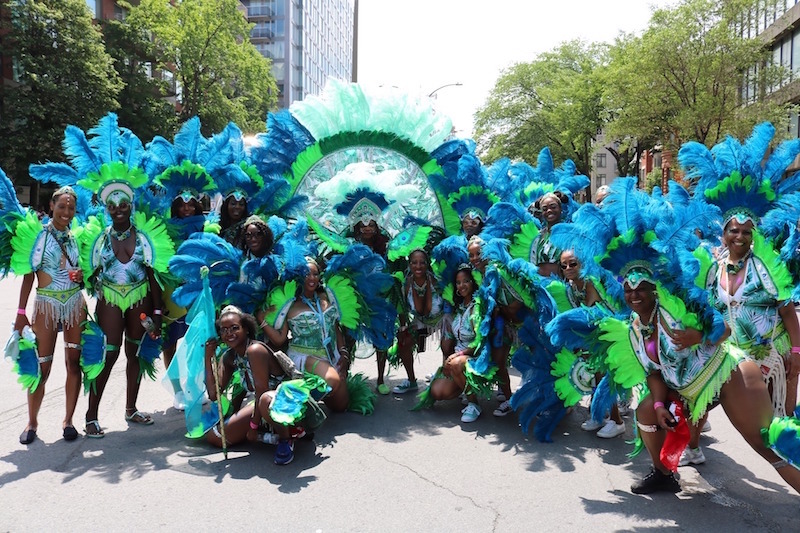Caribbeans in Canada use musical festivities to shine a global light on their culture
While Canada might be best known for its harsh winters and polite citizens, many seem to overlook the extremely diverse blend of people who make up many of our major cities.
One of the most influential diasporas in Canada is the Caribbean one, comprising about two per cent of the population, or more than half a million people. In metropolises like Toronto and Montreal, Canadians of Caribbean descent use “Carnival” – a festival of Caribbean culture and traditions most widely known for its bumping music and vibrant costumes – to give other Canadians, and the world, a taste of what being Caribbean is all about.
Caribbean culture is known to revolve around music, having birthed internationally popular genres like soca, reggae, and dancehall. Its Carnivals represent just that. The importance of musical celebration is highlighted in its people’s history and existence. Carnival is a physical representation of Caribbean culture.
Montreal’s version of Carnival, Carifiesta, began in 1975, in an attempt to bring the celebration of Caribbean people and culture to the diaspora in Montreal. Since its inception, Carifiesta has continued to grow as local Caribbeans and non-Caribbeans alike submerge themselves in the celebration of Caribbean nations’ music, creative expression, and vibrant energy.
At a Carnival’s main event, or “Grand Parade,” huge amounts of participants walk among massive, creatively-designed floats stacked with mega speakers, while each respective DJ blasts Caribbean anthems from the float. Participants dress in creatively-designed costumes with feathers and vibrant colours, walking side-by-side with the giant floats that flow down the streets on flatbed trucks.
Carnival’s origins can be traced back to the beginning of the 18th century on the island of Trinidad and Tobago. Many freed black slaves began to live among the Spanish and British settlers, carrying on their masquerade party traditions and taking it to a new level – one that still has its place in countries around the world today, as far as Switzerland and Japan.
The Carnival in Toronto takes shape in the form of the Toronto Caribbean Carnival, which began in 1967. With an extremely significant Jamaican population – about 71 per cent of Canada’s total Jamaican population – Toronto’s Carnival is the nation’s largest, with an estimated 1.1 million attendees earlier this month. It attracts close to 200,000 tourists and has an economic impact of approximately $400 million annually, according to the event’s Chief of Public Affairs, Denise Herrera Jackson.
The Toronto Caribbean Carnival takes place during the first weekend of August, with various Caribbean-themed musical jams held throughout the Greater Toronto Area. The Grand Parade, the weekend’s main event, is held on the Saturday every year. It features the extensive street parade, which is essentially a huge musical party on wheels. People gather to admire the costumes and float designs, while others walk among the floats and dancing crowd in the parade.
“The Grand Parade is the expression of freedom reminiscent of the freedom expressed in 1834, when slavery was abolished throughout the British Empire,” said Herrera Jackson, who’s also the producer of the Toronto Caribbean Carnival.
“Music is an integral part of the Toronto Caribbean Carnival and all other Caribbean Carnivals,” Jackson said. “Each year, new music is created in celebration of Carnivals in English, Spanish, and French-speaking Caribbean countries. This has resulted in a dynamic and exciting exchange of Caribbean music among Carnival aficionados and the development and internationalization of Caribbean music on the world stage.”
Montreal’s version of Carnival, Carifiesta, began in 1975, in an attempt to bring the celebration of Caribbean people and culture to the diaspora in Montreal. Since its inception, Carifiesta has continued to grow as local Caribbeans and non-Caribbeans alike submerge themselves in the celebration of Caribbean nations’ music, creative expression, and vibrant energy.
For Jason Forbes, Carifiesta’s public relations representative and liaison to the city, Carifiesta is an important event to help Caribbean-Canadians demonstrate their culture and even build connections with others interested in learning more about it.
“Carifiesta brings a festive event to the city where travelers across Canada and USA attend,” said Forbes. “It provides Montreal a way, as a city, to acknowledge our diversity and support our heritage. It also brings tourism and economy into the city each year.”
It provides Montreal a way, as a city, to acknowledge our diversity and support our heritage. It also brings tourism and economy into the city each year – Jason Forbes
Carnivals in Canada are consistently looking to widen the scope of their influence and impact, welcoming participants and volunteers of all walks of life. This is something that Forbes puts a lot of attention towards, as the event’s public relations representative.
“Carifiesta is a community run organization,” he said. “I would encourage any and every young person who reads this, to take ownership of Carifiesta. Inform yourself on how you can be a member and help contribute to build this beautiful representation of your heritage. No matter who you are, Caribbean or not, we are all one family.”
According to 22-year-old Montrealer and self-proclaimed “Carnival junky” Dhantae Ashby, the recipe to Carnival’s success throughout Canada is not as complicated or premeditated as some might think.
“From what I’ve observed in the past 10+ years of [attending the Toronto Caribbean Carnival], non-Caribbean people love our music, food and love to take pictures with the costumes,” he said. “They always seem to enjoy the vibe.”
Both the Toronto Caribbean Carnival and Carifiesta are set to be held next year during their usual weekend in August and July respectively. It’s safe to say that many are already awaiting Carnival’s return to Canada.
Feature photo courtesy of Carifiesta
